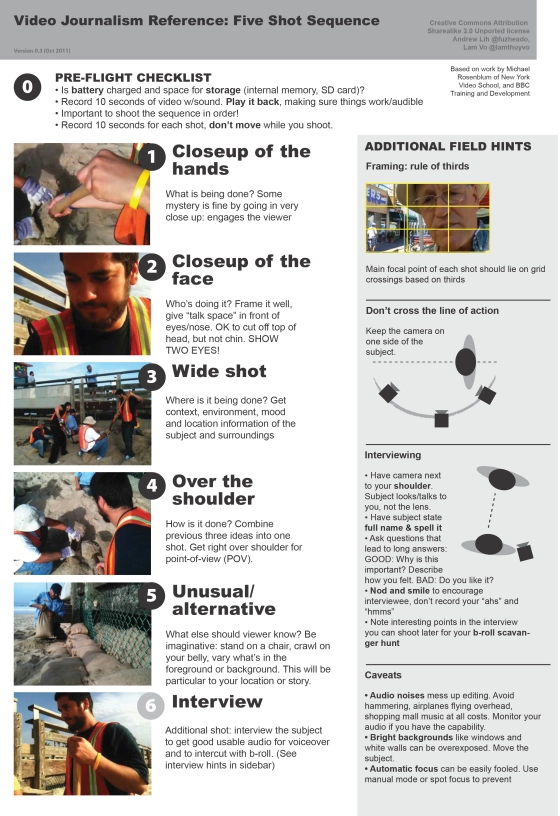B-ROLL ASSIGNMENT
B-roll is the extra footage captured to enrich the story you’re telling and to have greater flexibility when editing. Instead of featuring only talking heads on video, you want to have other images you can cut away to that will add dimension to your story. B-roll can include additional video footage, still photographs, animation or other graphic elements. Whenever you’re planning a video production, take some time out during the pre-production process to map out what B-Roll may be suitable. If you have a road map for several videos, any extra footage can be used for more than one project. Divide production between recording interviews and capturing b-roll.
Here are a few things to keep in mind when planning your video shoot:
- Depending on the type of video you are creating, evenly divide production between recording interviews and capturing b-roll. Having plenty of good b-roll makes a video more powerful.
- Because the times for capturing b-roll are often fixed (a certain activity only happens at a certain time), start by identifying the must-have footage and inserting that into your shooting schedule.
- Fill in the rest of the schedule with interviews and nice-to-have b-roll. If you discover, due to limited timing, that you need to sacrifice either a must-have piece of b-roll or a nice-to-have interview, I often recommend sacrificing the interview. The value of b-roll should not be underestimated, not only because it can strengthen the impact of your current video project, but also because it can serve as key footage for additional video assets created down the road.
ASSIGNMENT: You will write, record and edit a short narrative, which will include two on-camera stand-ups (beginning and end), at least two voice-overs (VOs), at least two b-roll shots, and a lower-third for the opening standup. You will shoot this as a group, but edit individually. Please watch the video below for further instructions:
FIVE-SHOT SEQUENCE
The following assignment is designed to help you to master your skills in shooting a video sequence, as well as:
-
-
Practice using camera angles that engage the viewer
- Practice composing shots that are effective visuals..
- How the single camera system works.
- How to get, evaluate and organize ideas for productions.
- Video and audio editing for single camera productions.
- Lighting on location.
- How to select locations.
- What equipment is needed for field production.
- Directing single camera productions.
- Personnel needed for single-camera productions.\The operation of various audio and video support equipment.
- Location set preparation.
- Evoking viewer emotion through camera angle, location, and editing.
-
Good video stories need strong individual shots. Great video stories present those shots in a sequence that complements the parts and creates a much greater whole. Shooting and editing effective sequences are essential video storytelling skills. Shot sequences can enhance cohesion, help communicate more information in less time and create an overall sense of purpose.
In video storytelling, a sequence is simply a series of shots that works together to show an action unfolding. Shot sequences are ubiquitous — most shots in most stories are part of a larger sequence. That’s because they’re a foundational storytelling tool in a medium that’s not only visual but also depicts the passage of time.
Benefits of shot sequences
Shot sequences offer three main benefits:
Shot sequences promote continuity. When audiences see a disparate collection of images that don’t seem to fit together, they often experience a sense of disorientation. They’re pushed away from, rather than pulled in to, the story. Sequences are the remedy. A good shot sequence creates a seamless progression. Everything seems to build as the sequence unfolds. When it ends, you’re ready for the next sequence to begin. This clarifies what you’re watching; it creates an impression that something continuous is unfolding before you.
Shot sequences compress time. A good shot sequence conveys the full meaning of an action or event without requiring real-time observation. That means you can express more ideas in less time, with fewer extraneous details.
Shot sequences add professional polish. A few simple steps can make amateur video footage a little more professional. You can take steadier shots (possibly by employing a tripod). You can minimize zooms, pans and other camera movements. And, perhaps most of all, you can shoot in sequences. A good shot sequence conveys purpose and direction. This sense of intention immediately bolsters the professionalism of a piece.
Key ingredients in sequences
Shooting sequences starts with identifying specific actions — discrete events that unfold visually and can be captured by a camera. The key to spotting actions is to get specific. Rather than “cooking dinner,” think “dicing a potato.” Rather than “delivering mail,” think “putting a particular letter in a particular mailbox.”
The most challenging part of identifying actions is figuring out what’s going to happen in advance so you’re ready to record when the moment comes. This is a skill that can seem intuitive, but it often emerges from thoughtful planning upfront.
Variety is another key consideration. Good sequences result from a diverse mix of angles, distances from the subject and compositions (how subjects are positioned in a shot). It’s especially important to use variety in back-to-back shots.
Together, specificity, anticipation and variety lead to strong sequences.
ASSIGNMENT: You will write, record and edit a scene, which will include one fire-shot sequence. For example, if your scene is about lunch, you might have a five-shot sequence of your subject selecting and buying lunch. Please keep the sequence to around 20 seconds.
- Keep this assignment short and simple (30-45 seconds at the most).
- Focus on the process or procedure for the event.
- Use rule of thirds
- Give headroom for subjects to look into.
- Don’t chop off the neck.
- Use a variety of camera angles (CU, EWS, POV, etc.).
- Steady images
- Effective lighting
